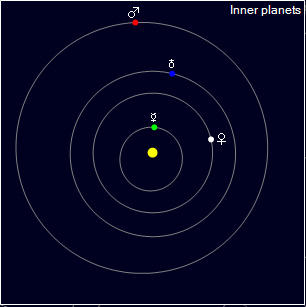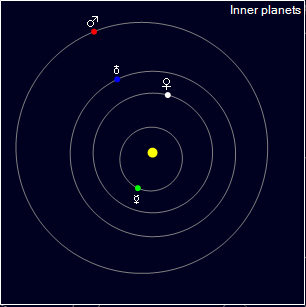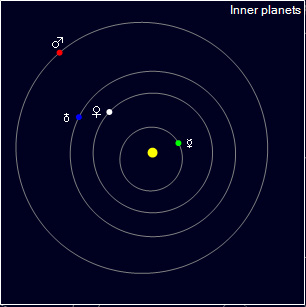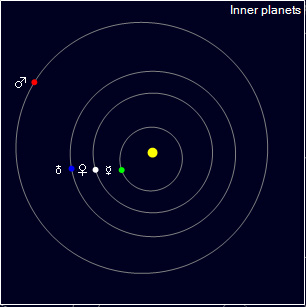Mars opposition is in mid-January next year. At that time, Mars will appear brightest, and through a telescope it’ll be as large as it gets (at about 14 arcseconds). If you’ve got the right type of telescope (see below), you should be in for a treat. The excellent photo above was taken at the last Mars Opposition (November 2022) by George Schwab using a Celestron Schmidt-Cassegrain. I’m loving those colours.
I was preparing my regular talk for the Astro society the other day and I found myself on a tangent (that never happens). I was describing events for the month and I noticed that the 8th of December 2024 is a busy day for planets. On that day, Jupiter is at opposition, and both Neptune and Mars are stationary, with Neptune’s retrograde ending, and Mars’ retrograde starting.
I wanted to say some things about retrograde motion, but I found that it’s not a well-understood thing any more. Back in the days of the great Greek and Arabic astronomers, it was of huge importance, destroying cosmologies and furrowing many brows.
So what is retrograde motion, and why was it so important in the development in human scientific thinking?
Retrograde motion
From our perspective, planets are different from stars in that they wander the heavens (the word “planet” means just this: a wanderer). Against the background of the stars they move over time.
If you watch the stars night after night, you’ll notice that as the year gets older, everything moves towards the west. In relation to the Sun, stars rise and set about four minutes earlier each night. You can confirm this in a planetary app on your phone. However, if you look at a planet, for most of the year, it still moves westwards, but it travels a bit slower, setting a little more than four minutes earlier.
Comparing the planet to the background stars, it looks like the stars are overtaking the planet as they both move westwards. In terms of celestial coordinates, the Right Ascension (RA) of the planet increases each day (again, check your phone app).
I say for most of the year, because planets don’t always do this. Every so often they stop moving slower than the background stars, and move faster for a while, overtaking the stars in the background. Then, after another while, they stop and resume their normal pace again. In terms of coordinates, the RA decreases each day during this time. What’s even more puzzling, is that some of the planets get significantly brighter while they’re being overtaken by the background stars.
What’s going on here?
Ancient astronomers’ view
Nobody believes that astronomers in the past were unintelligent. Starting from a basic understanding of what they saw, these people started to make hypotheses as to what was going on in the sky. Early Greek theories made the assumption that stars and planets were a fixed distance from a central Earth, and that the planets wandered around amongst the stars.
It wasn’t long before that most powerful phrase in science came up, “that can’t be right, look!” Brightening during retrograde indicated that the planet was getting nearer to the Earth, which destroyed the “fixed distance” hypotheses. Making a very long story very short, one theory led to another falsification, and eventually we made our way to how we currently understand our solar system. Nobody really thinks we’ve got it completely ironed out though.
So what’s going on with Mars?
Our current understanding of retrograde is that orbiting planets catch and pass each other like runners on a track.
The following five maps (courtesy of https://www.heavens-above.com/) shows the relative positions of the Earth and Mars at five dates.

This is the position on 31 October 2024. The planets are rotating anti-clockwise. You can see Earth (the blue one) coming up towards Mars (the red planet in the outer lane). This is late in the prograde period. During this time, a line drawn from the Earth through Mars and beyond to the stars rotates from the right to the left. That is, from the perspective of the Earth, Mars looks like it’s moving towards the left against the background.

This is what the situation will be on 8 December 2024. You see that Earth is approaching and has nearly caught Mars. At this point, from the Earth, Mars does not move against the background stars. We say that Mars is stationary, and that retrograde is beginning.

During retrograde, a line drawn from the Earth through Mars out to the background stars begins sweeping to the right as the Earth passes Mars. That is, Mars appears to move from left to right. On 16 January 2025, the date of this diagram, the Earth is directly alongside Mars, which is as close a the planets come. This is the point of opposition.

On 25 February 2025, Mars appears stationary again. Retrograde has now ended.

This is the position on 1 April 2025, which is well after retrograde has ended. Mars is now moving in prograde motion again, and appears to move from right to left against the stars.
How it looks from Earth
Have a look at this Stellarium screenshot. This is how Mars is going to move over the next six months or so, compared with the background stars. Starting on the left, it’ll wander rightwards before stopping on the 8th of December. Then it will start its retrograde, moving back to the left. This is where the Earth is catching and passing Mars on the inside lane. Opposition, 16 January, is about half way through its journey back to the left. It turns again on 23 February before resuming its rightward (prograde) trajectory. The screenshot itself is for May 2025, well into prograde.
I love the loopy trajectory. That shape has seriously messed with astronomers’ heads in the past!
Viewing the opposition
Mars opposition is in mid January. This is your best opportunity to have a close-up look at the planet. Because it’s at opposition, Mars will be directly overhead (well, on the meridian) at midnight. I’d encourage everyone to get to a telescope, preferably with a generous focal length, such as the Celestron Evolution 6, a Sky-Watcher 127/1500 AZ-Go2 Explorer, or saxon AstroSeeker 127. At other times, Mars is tiny.
Finally, I’ll have to look up how Mars in retrograde is going to effect my personal well-being. Oh, that’s right, it doesn’t!






